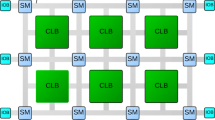Abstract
This paper presents fault modeling and analysis for bridging defects in a synchronizer that is implemented by two D flip-flops. Bridging defects are injected into any two nodes of the synchronizer, and HSPICE is used to perform circuit analysis. The major purpose of this analysis is to find all possible faults that might occur in the synchronizer. Simulation results demonstrate that bridging fault effects of the synchronizer depend on fault location, bridging resistance value, the input signal (rising and falling), and the time of input signal application. The issues of bridging fault behavior under the consideration of process variation, and the relationship between bridging faults and the synchronizer failure mechanisms are also discussed.
























Similar content being viewed by others
References
Al-Ars Z, Hamdioui S, van de Goor AJ, Mueller G (2008) Defect oriented testing of the strap problem under process variations in DRAMs. In: Proc int test conf, 28–30 Oct 2008, pp 1–10
Al-Assadi W, Malaiya Y, Jayasumana A (1993) Faulty behavior of storage elements and its effects on sequential circuits. IEEE Trans VLSI syst 1(4):446–452
Cummings CE (2001) Synthesis and scripting techniques for designing multi-asynchronous clock designs. http://www.sunburst-design.com/papers
Dally WJ, Poulton JW (1998) Digital systems engineering. Cambridge University Press, New York
Ginosar R (2003) Fourteen ways to fool your synchronizer. In: Proc ninth int symposium on asynchronous circuits and systems, pp 89–96
Hawkins C, Segura J (1999) Test and reliability: partners in IC manufacturing, part I. IEEE Des Test Comput 16(3):64–71
International Technology Roadmap for Semiconductors (ITRS): Design (2007). http://www.itrs.net/
Kim HK, Jone WB, Wang LT (2009) Analysis of resistive open defects in a synchronizer. In: Proc of int symposium on design and fault tolerance in VLSI system, pp 164–172
Lines A (2004) Asynchronous interconnect for synchronous SoC design. IEEE Micro 24(1):32–41
Metra C, Favalli M, Olivo P, Ricco B (1993) Testing of resistive bridging faults in CMOS flip-flop. In: Proc. of European test conf., pp 530–531
Polian I, Engelke P, Becker B, Kundu S, Galliere J-M, Renovell M (2005) Resistive bridge fault model evolution from conventional to ultra deep submicron. In: Proc. VLSI test symposium, pp 343–348
Predictive Technology Model (PTM) (2008) Released by Arizona State University. http://www.eas.asu.edu/~ptm
Rabaey JM, Chandrakasan A, Nikolic B (2003) Digital integrated circuits: a design perspective, 2nd edn. Prentice Hall, Upper Saddle River
Rodriguez-Montanes R, Figueras J (1994) Analysis of bridging defects in sequential CMOS circuits and their current testability. In: Proc. European design and test conf., pp 356–360
Wang LT, Wu CW, Wen X (eds) (2006) VLSI test principles and architectures: design for testability. Morgan Kaufmann, San Francisco
Weste N, Eshraghian K (1993) Principles of CMOS VLSI design: a systems perspective. Addison-Wesley, Reading
Yang F, Chakravarty S, Devta-Prasanna N, Reddy SM, Pomeranz I (2008) On the detectability of scan chain internal faults an industrial case study. In: Proc. VLSI test symposium, pp 79–84
Yang F, Chakravarty S, Devta-Prasanna N, Reddy SM, Pomeranz I (2008) Detection of internal stuck-open faults in scan chains. In: Proc. int. test conf., pp 1–10
Author information
Authors and Affiliations
Corresponding author
Additional information
Responsible Editor: B. Al-Hashimi
Rights and permissions
About this article
Cite this article
Kim, HK., Jone, WB. & Wang, LT. Fault Modeling and Analysis for Resistive Bridging Defects in a Synchronizer. J Electron Test 26, 367–392 (2010). https://doi.org/10.1007/s10836-010-5150-2
Received:
Accepted:
Published:
Issue Date:
DOI: https://doi.org/10.1007/s10836-010-5150-2




